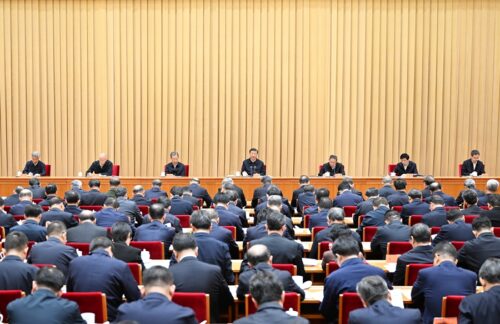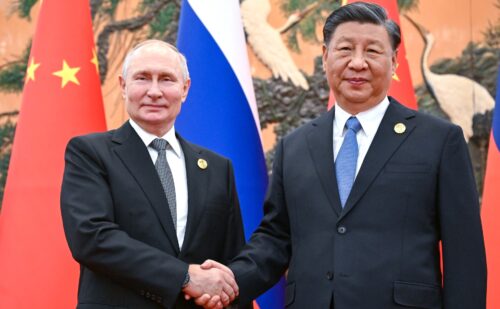
Something in China changed this year. Citizens have a new appreciation of their power even against a highly repressive party-state armed with advanced surveillance technology, argues scholar Lynette H. Ong.
Beijing has decided to relax its Covid restrictions. But, its implementation has been patchy across different localities, and Covid infection is soaring in some cities. All this is creating chaos and confusion on the ground. Even though lockdowns are no longer a constant feature of Chinese everyday lives, the country’s political landscape has been transformed permanently, albeit with temporary reprieve, by the Covid protests in the past weeks.
The unprecedented protests that swept across China in late November and early December were extraordinary at many levels, and they will likely produce significant implications for the country’s social stability in the near to medium-term. State-society relations are severely strained, and civic consciousness of the illegitimacy of the Party-state’s “everyday state power” as exercised by grassroots implementors such as the hazmat-suit-wearing COVID policy enforcers known as “big whites” (dàbái 大白) has been aroused. The intransigent COVID-zero policies of Xí Jìnpíng 习近平 have taken China down a path of no return.
How did we get to this point?
China has prided itself for its impressively well-resourced repressive system that has the capacity to nip contention in the bud before people go out to the street. The system relies on both social surveillance and state-of-the-art technology to sniff out dissent. Why did both fail miserably in pre-empting the wave of COVID protests?
The strategies of outsourcing repression by mobilizing trusted local non state actors to keep an eye on the community or assigning the responsibility to “grid managers’ ‘ in urban centers are labor-intensive, and can only target selected individuals. These are the individuals with previous criminal records or subversive behavior. For instance, the lone protestor who hung the banner across Beijing’s Sitong Bridge in October on the eve of the 20th Party Congress that loudly proclaimed that Xi Jinping was a dictator, and demanded freedom instead of lockdown is likely someone who was not previously on the party’s watch list.
The other part of the system depends on closed-circuit television cameras and artificial intelligence that can read faces, remember fingerprints, and track people’s movements. China’s digital health codes have been used by the authorities as a control measure to prevent protesters from rural areas from boarding trains to big city where demonstrations may have been planned to take place. Digital health codes of these targeted citizens turned from green to red, barring them from entering any public place, including train stations. However, when it came to citizens that the Party had no reason to become suspicious of, or when congregations took place in public squares or open streets that required no pre-screening, preventive digital surveillance proved to be limiting.
Second, even though Chinese society is no stranger to protests, there have not been any sustained cross-regional movements since the Tiananmen demonstrations in 1989. What is it about COVID-zero protests that differentiated them from the rest? Protests in China are typically issue-based, centering around concerns over livelihood, such as land grabs, housing issues, labor protests, property disputes, and environmental concerns. Because they are grievance-based, citizens who protest about different issues have no reason to collaborate even if they are based in the same city.
It is also incredibly challenging to organize collective action in China. A primary reason is that repression of civil society organizations has precluded any mobilizing structure for large-scale social movements. For instance, the lack of independent trade unions in China means workers need to mobilize individuals who share the same firm- or locale-specific grievances, which is a costly process compared to mobilization of existing members of a civil society organization. Consequently, even protests about the same issue tend to be fragmented regionally because there is no common platform to bring all the protestors together.
To be sure, COVID protests were about livelihood issues too — at the initial stage. In November, migrant workers in “urban villages” in Guangzhou protested lockdowns that affected their income.
Earlier, in October, Foxconn factory workers in Zhengzhou staged resistance against the discrepancies in salaries between actual salaries and those promised at the time of recruitment. There were also complaints about unsanitary conditions of dormitories in the closed-loop production centers where workers were forced to live and remain inside the company’s compound with limited interaction with the outside world. Thousands of Foxconn workers decided to take the “exit” option to leave the factory in the middle of the lockdown. These migrant workers from rural villages in Henan province decided to walk for hours on foot to return home or to the nearest transport center. The migrant workers in Guangzhou and Foxconn factory workers were more concerned about their income being affected by the lockdowns than the lack of liberty or freedom of movement.
Up until late November, anti-COVID protests remained isolated, restricted to cities that handled the lockdowns badly.
The turning point
The turning point occurred in Urumqi on November 25 where 10 people died in a building fire because the fire engine could not reach them due to lockdown barriers. That became the spark that started the prairie fire of COVID protests across China — even though years of political crackdown in Xinjiang against Uyghirs and other Muslim minorities have hardly provoked any sentiments in the Han-majority regions. On the following day, hundreds of students at the Nanjing Communication College congregated and raised blank sheets of A4 paper as a sign of defiance. That marked the beginning of the so-called “A4 Revolution” in China and across the world in support of the Chinese protesters. Blank sheets of A4 paper have been interpreted to signify the people’s voicelessness or no word is needed to communicate their grievance as if “you just know”. In the autocratic state where open defiance is an extremely risky pursuit, holding up a blank sheet of paper minimizes the cost of the defiant act for the participants.
The protests then spread to more than a dozen medium- and large-scale cities in coastal and inland China. The participants were mostly urban residents and students. When a group of Shanghai residents gathered at Urumqi Middle Road in the downtown commercial district on November 26 and shouted, “Down with Xi Jinping! Down with the Communist Party!” it could be easily mistaken as a sign of a revolution in the making. The protests that broke out on the campuses of the prestigious Tsinghua and Peking Universities in Beijing the following day became the harbinger of student movement across different cities. On November 28, hundreds of Beijing residents congregated at Liangma Bridge and shouted anti-regime slogans, despite an obvious police presence. As a loud reminder of the 1989 Tiananmen movement, student protests are likely to be highly unsettling for Xi Jinping. Even though the numbers of people at these demonstrations were only in the hundreds, the anti-regime nature of the protests went far beyond COVID zero. These anti-Xi Jinping sentiments have likely been simmering for some time, probably since the abolition of the presidential term limit, and the pressure imposed by COVID-zero lockdown became a political opportunity that provided the umph for the emergence of anti-regime protests.
Can the citizens be mollified?
Since November 30, cities across China have been relaxing lockdown restrictions, and in the last week, nearly all restrictions appear to have been dropped, which can be seen as a concession offered by the Party to mollify the protestors. Will that be sufficient to pacify the aggrieved citizens though? Only to a certain extent. For the migrant workers and small business owners in “urban villages” who protested lockdowns for their impact on income, relaxation of controls will help to reinstate their business operations. However, for the urban middle class and students who have demanded political change far beyond the COVID-zero framing, this concession will not be sufficient.
Hence, the government has also been applying repression to the protestors. Citizens have had their phones randomly checked on the street for downloading Telegramsand other western communication apps, and for protest-linked content. Working with mass technology platforms, the government has also used surveillance technology to track the movements of protest participants. The technology that failed to pre-empt people from turning up to the street earlier will be more effective in tracking targeted individuals. Once you are on the government’s watch list, the antennas of state surveillance will pick up the signal for potential dissenting acts quickly.
However, none of these measures, neither the concession nor ex-post crackdowns, will extinguish the flame of anti-regime sentiments openly expressed in the streets of Shanghai and Beijing and across university campuses. They broke a critical psychological threshold of fear that has been collectively holding the people back despite long existing discontent against the government. This broken threshold will take China under Xi Jinping down the road of no return — the birth of a restive society that will be increasingly challenging to govern. Don’t be mistaken though, it will not topple the regime anytime soon, but the seeds of a potential future popular protest movement have been sown.
Looking back, a lot has changed in the past few weeks. These changes are beyond cosmetic. The contentious activities in the aftermath of the 20th Party Congress are a manifestation of the regime’s “overreach” beyond its capacity, rather than the triumphant consolidation of power that many observers saw in the re-appointment of Xi Jinping for the third term. Performance legitimacy that has served the regime so well for years has been severely eroded over the past week.
This will likely have implications for elite politics and the cohesion among political elites who surround Xi Jinping, even though it is still early days to discern what the changes maybe. In 1989, the elites were divided along the line of the conservatives vs. liberal reformers. The liberal faction associated with then Premier Zhào Zǐyáng 赵紫阳 gave the protestors much needed morale booster in critical times. It is difficult to imagine such a faction or individuals exist any longer in the upper echelons of power after the 20th Party Congress. Even if there were such a liberal figure, he would be so isolated that he would not publicly speak out in support of the protestors. In spite of that, it does not mean the elite politicians are not watching the protests closely. China is now at a critical juncture — one in which history has provided little guidance on its political future.






